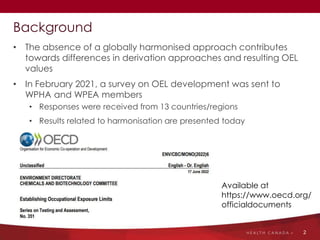Potential for harmonisation results from the OEL report Michelle Deveau Health Canada.pdf
- 1. Potential for Harmonisation: Summary of Results from the OECD Report OECD Online Workshop ŌĆō Approaches for Establishing OELs October 24, 2022
- 2. ŌĆó The absence of a globally harmonised approach contributes towards differences in derivation approaches and resulting OEL values ŌĆó In February 2021, a survey on OEL development was sent to WPHA and WPEA members ŌĆó Responses were received from 13 countries/regions ŌĆó Results related to harmonisation are presented today Background 2 Available at https://www.oecd.org/ officialdocuments
- 3. Current commonalities in OEL processes ŌĆó Similarities in overall OEL derivation processes ŌĆō Durations ŌĆō 8h-TWA for chronic and 15-minute STEL and Ceiling values for acute ŌĆō Human-relevant critical effects commonly based on sensory irritation, systemic effects, and specific target organ toxicity ŌĆō Key studies are typically epidemiology and experimental studies published in scientific literature ŌĆō OELs are derived for threshold toxicants by dividing a POD by uncertainty factors ŌĆō All countries use hazard notations (most commonly the potential for toxicity from dermal absorption) ŌĆó Differences typically result from specific policy decisions 3
- 4. Current status of harmonisation ŌĆó Existing processes already involve some alignment of organisations: ŌĆō Some collaboration and coordination already exists within countries/regions ŌĆō Use of existing OELs as starting points ŌĆó Health-based values: ACGIH, SCOEL/ECHA RAC, German MAK Commission, DECOS ŌĆó Highlights the value in making health-based OELs (and the methodology for their derivation) publicly available ŌĆó Efficient use of resources by using existing scientific opinions as a starting point was mentioned as a success of a program ŌĆó Lack of alignment across organisations was stated as challenge: ŌĆō Lack of control over timing of other organisationsŌĆÖ publications ŌĆō Development of OEL may be postponed if other organisations plan to evaluate same chemical 4
- 5. ŌĆó Most survey respondents were open to additional harmonisation activities Guidance - General OEL derivation - Confidence/addressing uncertainty - Deviation from defaults - Acceptable levels of risk - Criteria on differences of OELs from general population values Information sharing - Timing of assessments/workplans - Sharing of new studies - Sharing documentation for OELs - Exchanges on research on new risk assessment methodologies Work sharing - Sharing common prioritization processes - Division of labour for evaluating scientific literature - Identifying PODs Policy alignment - Deriving common OELs - Least likely to occur due to differences in approaches/policies and needs Interest in further harmonisation 5
- 6. Potential benefits of harmonisation ŌĆó Reduced redundancies ŌĆō Saves both time and financial resources ŌĆō Potential to increase number of existing OELs and updated older OELs ŌĆó Provision of standardised level of protection of workers ŌĆō Also can benefit employers if compliance requirements become standardised ŌĆó Information sharing could facilitate harmonisation ŌĆō Increased transparency in OEL-deriving processes could improve harmonisation 6
- 7. Potential barriers to harmonisation ŌĆó Lack of documentation of methodologies ŌĆó OEL documentation is not always readily available ŌĆó Different timing of assessments and priority of chemicals ŌĆó Differences in policies and approaches ŌĆó Different needs 7
- 8. Summary/conclusion ŌĆó Some degree of harmonisation and coordination is already occurring ŌĆó Survey respondents were generally interested in pursuing additional harmonisation activities ŌĆó Types of harmonisation activities proposed ranged from developing guidance and sharing information to work sharing and policy alignment ŌĆó Harmonisation activities proposed could be performed despite differences in policies, approaches, and needs 8
- 9. Acknowledgements Ayah Abdul-Hussein Meagan Bacciaglia Tara Barton-Maclaren Christine Lemieux Sarah Vanden Hoven Angelika Zidek 9 Tomoko Aoyagi Patience Browne Linda Rubene Koki Takaki Hannah Thabet Members of WPHA, WPEA, and OEL subgroup Survey respondents









